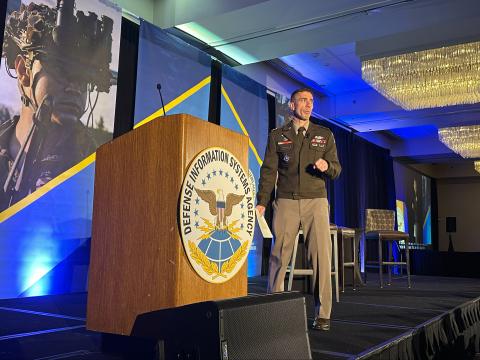Military Marches Toward Harmonized Acquisition Processes
Users wrestle with uniform purchasing systems that support accountability.
As the Standard Procurement System reaches the installation halfway point, U.S. Defense Department officials are highlighting how the technology makes the department more responsive to Congress and the American taxpayer. Although some personnel are still wary of the new system, the department is forging ahead, and the U.S. Army has adopted additional capabilities that save time and money.
The Standard Procurement System (SPS) is being implemented incrementally. American Management Systems (AMS), Fairfax, Virginia, was awarded a $240 million, 10-year contract for Procurement Desktop-Defense (PD2), a commercial product that it modified to meet the Defense Department’s specific needs (SIGNAL, September 1999, page 75). A 14-member Defense Department Joint Requirements Board developed the initial list of features for the software and today continues as the central receiving point for suggestions on improvements and requirements as the software moves through various versions.
Although incremental installation is a practical approach to standardizing the procurement process in an organization as large as the Defense Department, it has resulted in a rolling base of new users who are resisting the change. The department and AMS continue to address this challenge with open communication, extensive training and an improved product.
The department’s procurement leaders are well aware of the reluctance of its personnel to adopt a new system, leaving behind familiar processes. But the importance of being able to track procurement and spending is so critical that they are encouraging users to stay the course and to appreciate that the warfighter will be the ultimate beneficiary of their efforts.
Addressing more than 500 attendees at an SPS users’ conference in Washington, D.C., Deidre Lee, director of defense procurement, Office of the Secretary of Defense, acknowledged the difficulty of adopting a new system. However, she added that today’s political and financial environments make the work both necessary and critical.
Lee pointed to the Chief Financial Officers Act of 1990, the Federal Acquisition Streamlining Act of 1994 and the Federal Acquisition Reform Act of 1996, saying that these legislative initiatives require all federal agencies to be held accountable for what they spend. Although the laws are several years old, the Defense Department still cannot account for all of the property it purchases or owns or the accounting activity that pays for it. The SPS is viewed as one solution to this problem.
“Taxpayers will no longer accept a deficit budget. Taxpayers are saying, ‘Tell us what you do. Measure yourself. Tell us how you did, then audit this information,’” Lee stated.
“And the budget—it used to be that we would say this is how much we want in the fall at budget time, and then in the spring say this is what we need. This has all changed. It is no more,” she added.
The changing procurement environment also calls for a new way of doing business. Procurement officials no longer purchase only specific products. “We are business brokers. There has been a change in what we buy. In the past, we’d buy products. Now, we buy services, and we’re moving into buying solutions. We say, ‘Here’s the problem. Give us the solution.’ We are buying more and more complex business arrangements. There are no longer contracts. Now, we have transactions,” Lee explained.
Warfighters do not care about this revolution in business processes, only that they get what they need, Lee pointed out. However, the taxpayer expects some accountability, and the Defense Department must deliver. “Because it’s so complicated, we can’t report to Congress what has been spent on what. If we don’t do this, we won’t get the money from Congress to support the warfighter. It’s a big circle. The money comes from Congress, so we have to track the money so we can get the money from Congress again,” she related.
Lee admitted that former systems may be easier but explained that they do not gather the necessary information to track the purchases. “It’s a little harder than it used to be. But have you all noticed that a contractor doesn’t work well when he doesn’t get paid?” she quipped.
Comparing the SPS to weapon and information technology systems’ design processes, Lee said that warfighters and commands adopted a spiral development approach so that they could eventually receive an end product that meets the ultimate requirement. “Warfighters have less when they start, but they will get it later, and at least they have something to start with. Now we have to do this ourselves,” she offered.
According to Gary J. Thurston, SPS program manager, Defense Contract Management Agency, this is an accurate description of how the SPS is progressing. PD2 improved as it moved from version 4.1a to 4.1e. Version 4.2, which is currently in the field testing stage, offers still more improvements, he notes.
Paul Renard, vice president and SPS program manager, AMS, explains that PD2 version 4.2 will be installed at the contract administration level where data sharing takes place. It encapsulates the contract and pushes it between an organization’s personnel. It also addresses some of the problems found in the 4.x versions and improves user friendliness.
“We have also improved our help desk, which receives about 1,500 calls a month. Some of the calls are for basic help with the software. Some of the improvements in version 4.2 came from information gathered through the help desk. When service members call with recommended improvements, they are referred to the Joint Requirements Board. The improvements have included additional fields, larger fields and edit checks on fields,” Renard relates.
Version 4.2 also allows users to add, remove or match clauses and text items via a new “Clauses” tab in the Purchase Requests/Purchase Modifications (PRs/PR Mods) section. It supports document generation for PRs/PR Mods.
Line item detail in version 4.2 allows multiple delivery quantities and destinations to be entered for each line item put in through the delivery schedule window. Applicable fields are automatically populated in line item detail from the national stock number database. In addition, the new version supports five standard segmented layouts for the four services and defense agencies for line of accounting.
In the Awards section, the new version offers the option to create basic agreements, basic ordering agreements and master agreements for repairs and alterations of vessels without line items or with line items that do not have quantities and/or prices. Quantity and price fields can be left blank for indefinite delivery/indefinite quantity contracts at the line-item level. The external award capability has been expanded to provide a generic award from which delivery orders on all types of forms can be created. The procurement instrument identification number and description can be changed prior to document release.
When evaluating an offer, PD2 version 4.2 users can enter or update contract cost and pricing information throughout the proposal negotiation life cycle, from the government estimate through the government negotiation. Solicitations, contract modifications and administration, and system administration capabilities also have been enhanced.
The importance of upgrading PD2 is mounting as the number of users soars. In 1997, the initial installation year, the software was set up for 3,812 users. By the end of 1999, more than 16,000 users had received the software, and by December 2000, this total reached 20,894. When the SPS is up and running across the Defense Department, it will standardize more than 50 legacy procurement cultures for approximately 43,000 users at 1,100 sites. The goal is to accomplish this task by October 2003.
Although the system tracked less than $14 billion in purchases in 1999, approximately $33 billion moved through PD2 last year, and an estimated $50 billion in committed funds will make its way through the system by the end of this fiscal year.
In part, introducing new versions contributes to some of the dissatisfaction from users, Thurston relates. The version a contract office uses depends on when it moved to the SPS. Each office implements the software when its leaders believe it is the best time to make the switch. This schedule can be affected by their current missions. As a result, some offices may be using version 4.1b, which was released in August 1999, whereas others may be using version 4.1c, which was introduced in April 2000 and meets additional Joint Requirements Board items.
Thurston points out that the Defense Department continues to work with AMS to maintain former versions and that as newer forms of version 4.1 were developed the department corrected deficiencies and integrated enhancements. However, he is concerned about offices that may choose to continue to use version 4.2 when version 5.0 is introduced. The newer version will have World Wide Web capabilities, and as it is currently designed, version 5.0 cannot be retrofitted to interact with 4.x versions.
Some organizations are not waiting for version 5.0 to begin taking advantage of the power of the Internet. The Army, which has more than 7,700 installed users, has purchased another AMS product that allows personnel to order products online. Purchase Request (PRweb), part of AMS’ AcquiLine suite of acquisition solutions, interfaces seamlessly with the SPS.
Gino Magnifico is the SPS component management officer for the Office of the Assistant Secretary of the Army for Acquisition, Logistics and Technology. He notes that using the traditional method of procurement, units fill out a requisition form, carry or send it to the resource manager who then approves the request and forwards it to the contracting office where the information is entered into the SPS. This process could take several hours to several days, depending on where each component is located.
PRweb streamlines this process by allowing users to create purchase requests from their desktop using any Web browser. The requests can then be routed electronically to other PRweb users for additional information, funding commitment and approval, all according to locally defined business practices. From there, they are inserted directly into the contracting office’s PD2 system for processing. The software also allows the requiring party to track the order.
Magnifico explains that PRweb helps the Army accomplish a number of goals. It eliminates the need to re-key purchase orders, removing one opportunity to introduce errors. The paperless distribution of an order decreases the amount of paper that must be maintained, which reduces processing costs. In addition, the status of orders can be checked at any time.
“The initial wave of paperless contracting is the distribution. There is still a lot of paper, and there will be. But we are saving time,” Magnifico offers. While the Army once used the figure $100 per order saved to describe the benefit of going paperless, today officials say the efficiency that is gained is more beneficial than the money saved, he adds.
More than 9,000 Army professionals are using the application, and the user base is expected to skyrocket to more than 40,000 in the next three years.
The Contract Never Written While the U.S. Defense Department touts the Standard Procurement System (SPS) as a necessary improvement in business processes, the technology is not the final chapter in revamping acquisition for the military, according to Rear Adm. Gwilym H. Jenkins, Jr., USN, deputy for acquisition and business management, Office of the Assistant Secretary of the Navy for Research, Development and Acquisition; and competition advocate general, U.S. Navy. Instead, the SPS is one part of an evolutionary process that will move contracting officers from being contract writers to being content generators, which is a new way of doing business. “The best contract I ever had is the one I never wrote. If you have to write a contract, you’re lead-time away,” Adm. Jenkins contends. While the SPS is a vast improvement on former methods of procurement, the future of acquisition lies in establishing contracts that can be ordered against. “So the model of the future is the contracting officer creating the marketplace and the customer just ordering from it,” he explains. The government customer today is getting an ever-expanding market that mimics the consumer marketplace. Future military buyers will have a different role than the one they play today. “Today, they buy things. We’re evolving to where the contracting officer is a business alliance officer,” the admiral says. In the future, acquisition professionals will network their resources based on their current needs. They will use existing instruments first, and only write a contract as a last resort, the admiral contends. The Navy/Marine Corps Intranet (NMCI) will support this vision, Adm. Jenkins states. “The NMCI will prove to be an absolutely awesome step forward in the way we do business. This is a tool to do strategic alliances in a way they have not been done before,” he states. In fact, the Navy has already moved in this direction. Buying consortia have been established in every region where the Navy has a major presence. During the past two years, Navy procurement offices have examined their purchases and networked this knowledge to create buying leverage. Although to date only modest savings have been realized using this approach, the admiral points out that over time this technique is likely to produce increased benefits. It would be a logical step for the entire Defense Department to move in this direction and apply it to not only products but also contracts, he says. The admiral believes that more than just the procurement process will change. In the future, the quality of products is also likely to evolve. Like automobiles, the products that the military buys will move from needing constant repair to having consistent durability. For example, cars produced in the 1960s required continuous maintenance; however, today’s automobiles are built in a way that requires less upkeep. The goal is to design weapons systems so that they do not need to be repaired as often. As a result, parts requisitions will decrease, Adm. Jenkins states. In addition to the SPS, today’s procurement establishment already has seen some of the changes that will take place in acquisition during the next several years. The admiral points to the Defense Department’s e-mall, the government’s purchase card and the reverse-auction method of purchasing. These are examples of the effect technology has had on procurement processes, and they are likely to continue, he says. “No system is static, and you wouldn’t want it to be. In order to stay up with technology, things have to evolve,” the admiral relates. |




Comments